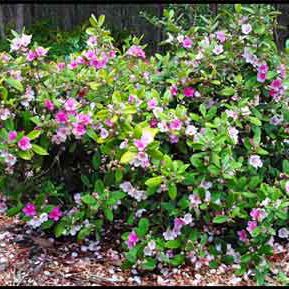Rhodomyrtus tomentosa
Hill gooseberry, Ceylon hill gooseberry, downy myrtle
Origin
Hill gooseberry (HG) is native to India, south east Asia and the Philippines, and is now found elsewhere throughout the tropics and sub-tropics. There are two varieties – var tomentosa (HGT) which is found in south east Asia, China and Indonesia and has longer pedicels than var parvifolia (HGP) which is found in India and Sri Lanka. Outside its native area it is often considered an invasive species, eg. in Florida and Hawaii. Its weed classification in Australia varies by state – in WA it’s a declared noxious weed whereas in Queensland and NSW it’s not listed, with several nurseries selling plants.
Climate
HG is a cool tropical to warm sub-tropical species that can tolerate some salt spray and temperatures down to -6°C. It is fire-adapted with prolific re-sprouting, and thrives when annual precipitation is more than 1200mm. HGT is more tolerant of harsh low-land environments up to 300m elevation whereas HGP prefers 1800-2400m with more forgiving conditions.
Plant Description
A small evergreen shrub, 2-3m high with tomentose branchlets. The opposite leaves are sub-coriaceous, ovate-elliptic, 5-8cm long X 1-5-4cm wide with an upper glossy glabrous light green surface and lower densely tomentose, HGT whitish and HGP more yellowish . Petioles are 4-10mm long.
Relatives
It is a member of the large Myrtaceae family (145 genera, >5500 species) which includes the many species of Syzygium and Eugenia – feijoa, pitanga, jaboticaba, cherry guava and guava. There are 23 species in the genus.
Soils
Plants do best in deep, slightly acid sandy soils. They can tolerate poor drainage and some sodicity but are intolerant of alkaline or calcareous soils.
Propagation
A high percentage of seeds germinate readily and this is the normal means of propagation. Cuttings are more problematic.
Cultivars
No named cultivars. Potential for selective breeding.
Flowering and Pollination
Inflorescences are axillary cymes usually with 1, but up to 3 bisexual flowers, each with two small bracts, 4-5 sepals 3-4mm long and 4-5 tomentose pink petals 10-13mm long. There are numerous stamens, an inferior tri-locular ovary with each cell having two rows of ovules, and a thin central pink style. Flowering is normally in spring for 2-3 months, with flowers opening in the morning and lasting 2-3 days before fading and abscission. Flowers have no odour or nectar. Release of viable pollen and stigmatic receptivity is only effective on the first day and the pollinators, various bee species (wind is not involved), mainly visit in the first morning. Stigmas require pollen from another flower to be fertilized.
Cultivation
There is little information available regarding cultivation practices, as in suitable habitats they normally look after themselves. A location with full sun is preferred. Their small compact size means they are very suitable for growing in pots.
Wind Tolerance
Minimal problems given their small bushy nature.
Pruning
Minimal.
The Fruit
Fruit is an ellipsoid-globose berry, 12-14mm long, which turns from green to purple-violet-black as it matures. It has persistent sepals at the apex and 40-45 1.5mm diameter seeds embedded in the flesh. Pulp is soft, purplish and sweet. Immature fruit is slightly astringent. For a fruit, it has good levels of Fe and Ca; carbohydrate content is 11%, mainly sucrose and glucose.
Fruit Production and Harvesting
Seedling trees begin to fruit in 3-4 years. Time from flowering to ripening and harvest is about 65 days.
Fruit Uses
The whole fruit is consumed fresh or processed into jams, jellies and various preserves.
Pests and Diseases
Minimal apart from birds.
Comments
This is an easy plant to grow – too easy in some locales with their potentially invasive/weedy nature. Birds are attracted to the ripe fruit and then contribute to possible environmental problems by disseminating seeds. So be a commendable citizen and use bird netting – the added spin-off is more fruit for you! It is an attractive plant, often grown purely for its ornamental value.
